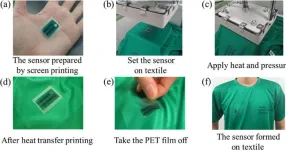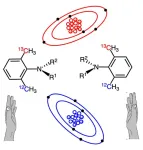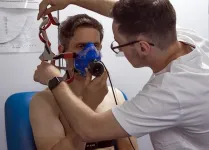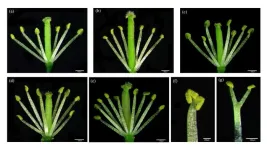(Press-News.org) The American Society for Biochemistry and Molecular Biology sent feedback in June to the National Institutes of Health about its proposed changes to the Ruth L. Kirschstein National Research Service Award fellowship application and review process.
The proposed changes indicate that the NIH adopted nearly all of the ASBMB’s earlier recommendations (here and here) to reduce institutional and investigator bias and refocus the evaluation on an applicant’s potential and the impact of the proposed training.
“We are thrilled with the proposed changes to the NRSA application materials and review guidelines,” said Sarina Neote, ASBMB’s public affairs director. “The NIH and working group have done an excellent job at making this grant review process more equitable for all participants and applicants. We are confident that these changes will propel the scientific enterprise forward by investing in the next generation of scientists from diverse backgrounds and experiences.”
The NRSA fellowship is a multi-year grant designed to support doctoral or dual-doctoral degree candidates. According to the NIH, the award allows trainees “to obtain individualized, mentored research training from outstanding faculty sponsors while conducting dissertation research.” One important goal of this program is to enhance the diversity of scientists entering the biomedical, behavioral and clinical sciences, and the NIH encourages applications from scientists from underrepresented backgrounds, racial and ethnic groups as well as persons with disabilities.
Reducing bias
The NIH proposes restructuring the scoring guidelines to reduce emphasis on institution and sponsor. To achieve this, it would eliminate the “Institutional Environment and Commitment to Training” and “Sponsors, Collaborators, and Consultants” scoring sections. Reviewers would instead evaluate the “Science and Scientific Resources” and “Training Plan and Training Resources” categories.
The ASBMB said that change should help reviewers identify the most promising applicants while combatting biases favoring senior investigators at well-resourced institutions.
The NIH also proposes implementing implicit bias training for NRSA reviewers. The ASBMB supports this move, as it is consistent with the society’s previous recommendations.
Special circumstances
Another matter that the society’s previous recommendations to NIH raised was that of education and employment gaps. The ASBMB previously suggested that NRSA applications include an “Optional Statement of Special Circumstance” so that individuals could explain gaps in employment or education. The NIH adopted ASBMB’s suggestion.
In its June feedback, the ASBMB encouraged NIH to also include a list of possible reasons to submit an “Optional Statement of Special Circumstance,” such as a leave of absence due to caregiving or sexual harassment. The ASBMB said providing examples might “empower” applicants to share their circumstances and give them the “full opportunity to shine in their application without risking negative assumptions or bias.”
Better measures
NIH proposes removing grades from the NRSA application materials and adding a section in which applicants can describe leadership and volunteer experiences, both changes in line with the society’s earlier recommendations.
In its June feedback, the ASBMB said this will allow reviewers to get a better, holistic impression of applicants and encourage trainees to “develop important soft skills that are critical for successful research careers.”
One sticking point
Finally, the ASBMB raised concerns about the applicant self-assessment and sponsor reflection, both of which are designed to highlight areas in which the trainee can improve and/or acquire skills that will propel their future scientific career.
The ASBMB pointed out that the Federation of American Societies for Experimental Biology already has noted that the instructions for statements are unclear and present a potential opportunity for gamification and requested clarification.
About the American Society for Biochemistry and Molecular Biology (ASBMB): The ASBMB is a nonprofit scientific and educational organization with more than 12,000 members worldwide. Founded in 1906 to advance the science of biochemistry and molecular biology, the society publishes three peer-reviewed journals, advocates for funding of basic research and education, supports science education at all levels, and promotes the diversity of individuals entering the scientific workforce. For more information about the ASBMB, visit www.asbmb.org.
END
ASBMB weighs in on changes to NIH fellowship review
The society applauds removal of grades from the application, inclusion of applicant special circumstance statement and reviewer bias training
2023-07-06
ELSE PRESS RELEASES FROM THIS DATE:
Wastewater monitoring could act as pandemic early warning system
2023-07-06
Wastewater monitoring could act as an early warning system to help countries better prepare for future pandemics, according to a new study.
An international collaboration involving Murdoch Children’s Research Institute, The Rockefeller Foundation, Mathematica and the United Kingdom’s Health Security Agency has shed light on how different countries monitor wastewater during infectious diseases outbreaks and where improvements could be made.
For the study, samples from treatment plants, rivers, wetlands and open drains were reported ...
T cells require healthy “power plants”
2023-07-06
All cells have their own power plants, called mitochondria. There are often more than 100 mitochondria per cell and each possesses their own genome, which in turn contains genes responsible for energy production. If errors creep into these genes, this can cause problems in the cell and result in diseases. Scientists from the Berlin Institute of Health at Charité (BIH) and the Max Delbrück Center have now discovered that the T cells of the immune system are especially sensitive to genetic disturbances within their mitochondrial power plants. They have published their findings ...
Sweat it out: Novel wearable biosensor for monitoring sweat electrolytes for use in healthcare and sports
2023-07-06
The remarkable level of miniaturization possible in modern electronics has paved the way for realizing healthcare devices previously confined to the realm of science fiction. Wearable sensors are a prominent example of this. As the name suggests, these devices are worn on the body, usually directly on the skin. They can monitor important bodily parameters, including heart rate, blood pressure, and muscle activity.
Some wearable sensors can also detect chemicals in bodily fluids. For instance, sweat biosensors ...
New teaching method can even out children's reading skills
2023-07-06
How well do children know letters and their corresponding sounds? In Norway, the gender difference on these tasks when children start school is significant. The girls have a clear head start.
“We see these differences in all categories – for upper case and lower case letters, for the names of the letters and for their corresponding sounds,” says Hermundur Sigmundsson, a professor at Norwegian University of Science and Technology's (NTNU) Department of Psychology.
Girls’ letter-sound knowledge is clearly better than that of boys,’ and girls remain far better readers than boys at age 15. Since reading is key for so many ...
Scientists synthesize isotopic atropisomers based on carbon isotope discrimination
2023-07-06
In chemistry, a molecule or ion is said to be chiral if it cannot be superposed on to its mirror image by any combination of rotations, translations, or conformational changes. A chiral molecule or ion exists in two forms, called enantiomers, that are mirror images of each other; they are often distinguished as either ‘right-handed’ or ‘left-handed’ by their absolute configuration. Enantiomers exhibit similar physical and chemical properties, except when interacting with polarized light and reacting with other chiral compounds, ...
New study shows robust pandemic preparedness strongly linked to lower COVID-19 mortality rates
2023-07-06
New Study Shows Robust Pandemic Preparedness
Strongly Linked to Lower COVID-19 Mortality Rates
Preparedness matters: Accounting for age and national capabilities to diagnose COVID-19 deaths reveals that pre-pandemic investments in capacity saved lives—though U.S. remains an outlier.
The vast majority of countries that entered the COVID-19 pandemic with strong capacity to prevent, detect, and respond to disease threats achieved lower pandemic mortality rates than less prepared nations, ...
Species lump for the Western Flycatcher; species status for the goshawk of North America; and species splits in several Caribbean birds among 2023 Check-list changes
2023-07-06
The 64th Supplement to the American Ornithological Society’s (AOS) Check-list of North American Birds, published today in Ornithology, includes numerous updates to the classification of North American bird species.
A few highlights from this year’s supplement, detailed below, include a species lump for the Western Flycatcher, species status for the goshawk of North America, and species splits in several Caribbean birds leading to five additional species.
The Check-list, published since 1886, is updated annually by the AOS’s North American Classification Committee (NACC), the official authority on the names and classification of the ...
Study explores incarceration, employment and re-offense during COVID-19 pandemic
2023-07-06
There are more than 2 million people incarcerated in the United States. In 2019, more than 608,000 individuals were released from prison. It is estimated that up to 55 percent of people released from prison will be re-incarcerated within five years. The cause of high recidivism or re-offense rates in the U.S. is multi-dimensional. Moreover, the relationship between employment and crime is complex.
To combat an unstable work history and lack of interpersonal skills, some communities have implemented transitional employment programs, ...
How hot is too ‘too hot’ for humans?
2023-07-06
Ongoing research by Prof. Lewis Halsey and his team at the University of Roehampton, UK has identified that an upper critical temperature (UCT) exists for humans and is likely to be between 40°C and 50°C. Further research is now underway to explain this rise in metabolic energy costs at high temperatures.
Prof. Halsey and his team have found that resting metabolic rate, a measure of how much energy the human body consumes to keep ticking over, can be higher when people are exposed to hot and humid conditions. ...
Professor Tongming Yin 's team from State Key Laboratory for Tree Genetics and Breeding of Nanjing Forestry University proposed the role of MSL-lncRNAs in causing sex lability of female poplars
2023-07-06
Labile expression of sex was frequently reported by empirical observation in a variety of Populus species, but the underlying genetic mechanism remains largely unknown.
This article has been published on Horticulture Research with title: The proposed role of MSL-lncRNAs in causing sex lability of female poplars.
In this study, we carried out a systematic study on a maleness promoting gene, MSL, detected in Populus deltoides genome. Our results showed that both strands of MSL contained multiple cis-activating elements, which generated long non-coding RNAs (lncRNAs) ...
LAST 30 PRESS RELEASES:
Scientists to ‘spy’ on cancer- immune cell interactions using quantum technology breakthrough
Tech savvy users have most digital concerns
Making lighter work of calculating fluid and heat flow
Normalizing blood sugar can halve heart attack risk
Lowering blood sugar cuts heart attack risk in people with prediabetes
Study links genetic variants to risk of blinding eye disease in premature infants
Non-opioid ‘pain sponge’ therapy halts cartilage degeneration and relieves chronic pain
AI can pick up cultural values by mimicking how kids learn
China’s ecological redlines offer fast track to 30 x 30 global conservation goal
Invisible indoor threats: emerging household contaminants and their growing risks to human health
Adding antibody treatment to chemo boosts outcomes for children with rare cancer
Germline pathogenic variants among women without a history of breast cancer
Tanning beds triple melanoma risk, potentially causing broad DNA damage
Unique bond identified as key to viral infection speed
Indoor tanning makes youthful skin much older on a genetic level
Mouse model sheds new light on the causes and potential solutions to human GI problems linked to muscular dystrophy
The Journal of Nuclear Medicine ahead-of-print tip sheet: December 12, 2025
Smarter tools for peering into the microscopic world
Applications open for funding to conduct research in the Kinsey Institute archives
Global measure underestimates the severity of food insecurity
Child survivors of critical illness are missing out on timely follow up care
Risk-based vs annual breast cancer screening / the WISDOM randomized clinical trial
University of Toronto launches Electric Vehicle Innovation Ontario to accelerate advanced EV technologies and build Canada’s innovation advantage
Early relapse predicts poor outcomes in aggressive blood cancer
American College of Lifestyle Medicine applauds two CMS models aligned with lifestyle medicine practice and reimbursement
Clinical trial finds cannabis use not a barrier to quitting nicotine vaping
Supplemental nutrition assistance program policies and food insecurity
Switching immune cells to “night mode” could limit damage after a heart attack, study suggests
URI-based Global RIghts Project report spotlights continued troubling trends in worldwide inhumane treatment
Neutrophils are less aggressive at night, explaining why nighttime heart attacks cause less damage than daytime events
[Press-News.org] ASBMB weighs in on changes to NIH fellowship reviewThe society applauds removal of grades from the application, inclusion of applicant special circumstance statement and reviewer bias training




